I want to share Marrakech with you. This city feels like a warm, dusty hug. Why do People call it the Red City? Let’s discover together the origin of its red color hidden in its history, and a magic that stays with you even after you leave.
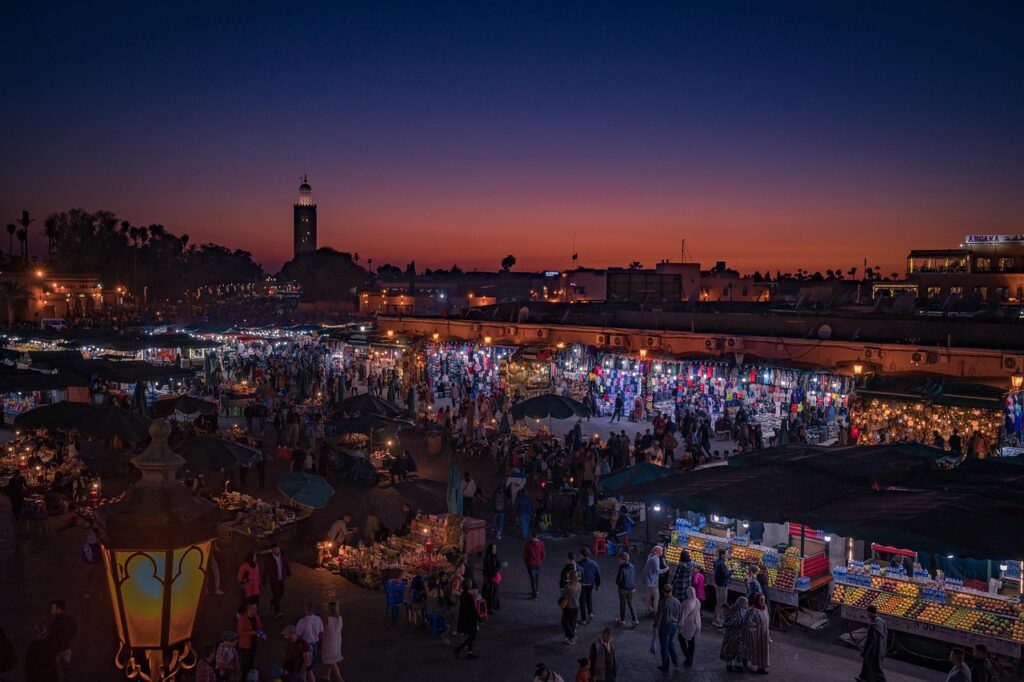
Let’s start discovering Marrakech
I still remember the time my father held my hand as we walked under the old archway of Bab Agnaou. I knew the color was just the start. The real magic was in the busy streets. I heard the sound of skewers sizzling in Djemaa el-Fna. I caught the thok-thok sound of woodcarvers working with cedar. A sweet scent of orange blossom came from a hidden riad.
I feel incredibly happy a few days after my trip to Marrakech. When I return, that first breath of fresh air makes me feel at home. It has mixed scents of woodsmoke, saffron, diesel, and wet earth. The airport helps visitors arrive quickly, but the genuine warmth comes from the medina. The streets there, which UNESCO protects, feel alive. They are not like a museum. They are filled with life, just like when my great-grandfather sold dates in these souks.
Every foreigner comes expecting the oriental charm they read about. What they see is even more thrilling. This city welcomes you and draws you into its lively atmosphere. Soon, the sound of the call to prayer feels like your heartbeat. Tasting mint tea feels familiar, as if your soul remembers it. This is the magic of my Marrakech; it doesn’t allow you to be just a visitor for long.
The Roots of Marrakech: From Berber Origins to Modern Times
When I was a kid, my grandfather often said that Marrakech started with desert nomads wanting walls. The Almoravids built the city in the 11th century. You can still see how the Koutoubia stands over us today. Later, the Al Mowahidin came and added books to our buildings. He would press his rough finger on my chest. But the true city belongs to the Berbers. They make bread, weave carpets, and trade for sunlight in the souk. These stones will always be remembered.
The historian said that Marrakech has experienced many changes, but I can tell you that the city has been taken over, cherished, and brought back to life several times. Each monument tells stories of an old Dynasty. In Jemaa El Fnaa with little attention, you can hear the wind carrying the voices of storytellers.
The Koutoubia Mosque: An Iconic Symbol of Islamic Architecture

When walking through the centre of Marrakech, you will notice the beautiful Koutoubia Mosque standing tall above the city like a silent guardian. The mosque’s minaret is over 70 meters high and dates back to the 12th century. It features lovely geometric patterns and elegant arches that glow in the sun, which shows the skill of the Al Mowahidin dynasty people.
Close to the Medersa Ben Youssef, the mosque is not just the largest place of worship in the city but also a lasting symbol of Morocco’s wonderful past. From its high place, you could see Marrakech spread out below it. On clear days, the distant Atlas Mountains peeked through the haze, making the moment feel even more special.
Bahia Palace: A Masterpiece of Moroccan Style
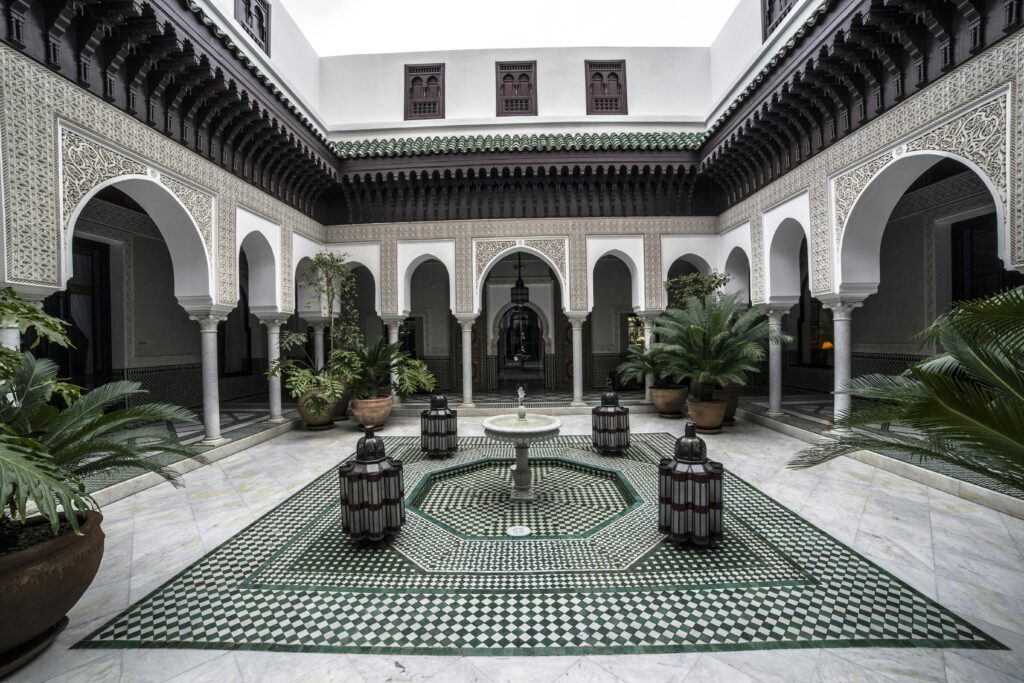
If you visit Al Bahia Palace, you will see winding paths, fountains, and lovely rooms. It is a charming place. Here, the beautiful gardens of the palace will give you a calm break from the city.
Make sure you visit the Dar Si Said Museum nearby. It is in another beautiful palace. You will see a great collection of Moroccan art and crafts. This will help you learn about the country’s rich art history.
Jemaa el-Fnaa: Where Marrakech’s Heart Beats Loudest
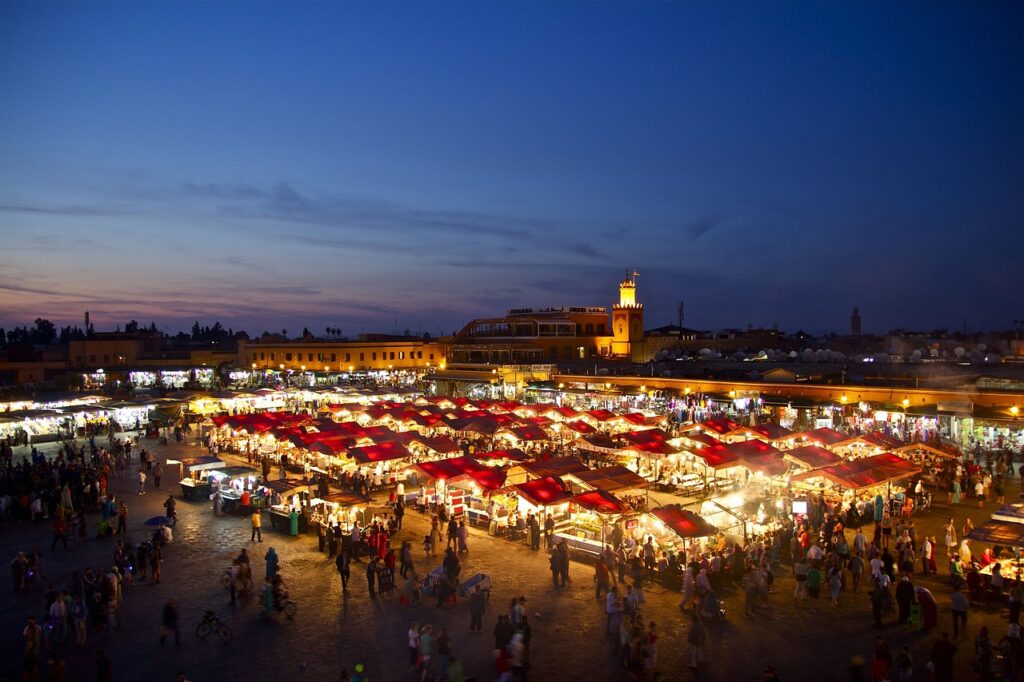
Ah, Jemaa el-Fnaa—everyone in Marrakech sees it as the city’s heart. Let me take you inside this special place. In the morning, it’s quiet and tranquil. You can spot orange juice sellers arranging their fruit. But by noon, the square becomes a lively stage for everyone.
- Snake charmers encourage cobras to come out of their baskets by playing lovely music on their flutes (but we locals know to watch from a safe distance!).
- Henna artists make beautiful, detailed patterns on people’s hands using skills passed down through generations.
- Storytellers gather crowds of amazed listeners, sharing tales that flow like the winds in the desert.
As the sun goes down, the fun starts in Jemaa el-Fnaa. Many lanterns shine bright. You can hear skewers cooking, the sound of a mortar and pestle mixing spices, and families enjoying hot plates of tanjia. You can sit at a shared table. A stranger may offer you a cup of mint tea. At that moment, you will feel a strong sense of community and connection in Jemaa el-Fnaa. It makes you feel welcome and at home.
The Souks: A Labyrinth of Wonders
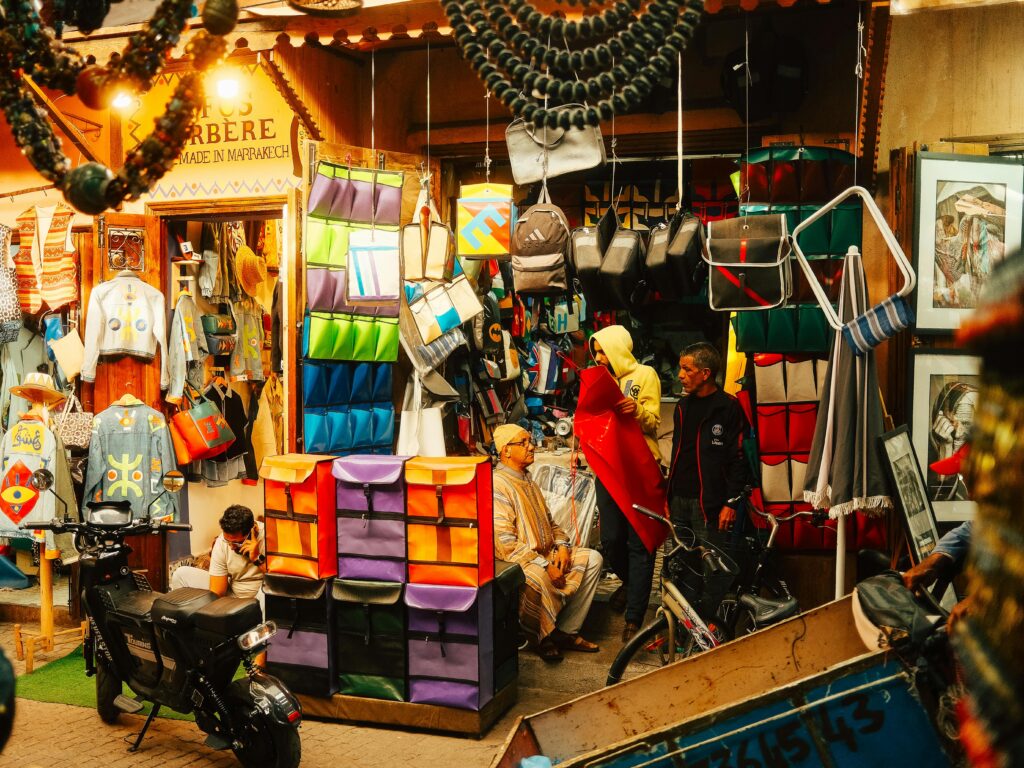
When you leave the squares in Jemaa el Fnaa and enter the souk, a maze full of surprises awaits. The air smells like saffron and cedarwood, guiding you along narrow paths filled with interesting finds. It’s a sensory experience that showcases the unique charm of Marrakech.
- Dyers’ Quarter: Silk threads are soaked in red and blue colors in stone pools. This practice has been done the same way since Marrakech was part of ancient trade routes.
- Carpet Souk: Berber women lay out wool rugs. These rugs have designs that are older than writing. Each knot is a prayer, and each color shows a part of the spirit of the Atlas Mountains.
- Metalworkers’ Alley: You can hear the ting-ting-ting of chisels shaping brass lanterns. These lanterns will create starry patterns on the walls of the riad for many years.
Pro tip from a local: If you get lost (which is likely), just look up at the wooden beams above the alleys. The ones that are carved will lead you to bigger streets. The plain ones take you to smaller paths. You can also follow the tasty smell of fresh msemen. It will lead you to a tiny stall where you can find golden and flaky pastries waiting for you.
Gardens & Getaways: Where Marrakech Breathes
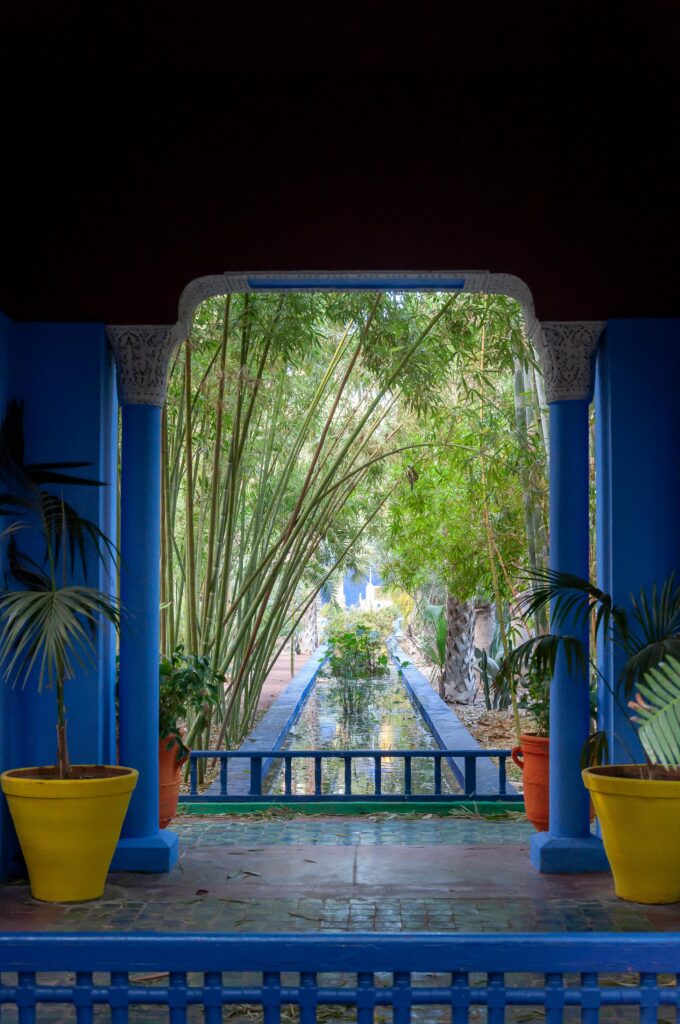
Our gardens provide this energetic city with some fresh air.
Jardin Majorelle is a stunning spot full of bright cobalt blue and sunny yellow colors. Yves Saint Laurent found much inspiration here. You can relax in the cool shade of banana trees and bougainvillea while enjoying your time.
The Menara Garden is a lovely spot. Olive groves stretch out towards the Atlas Mountains. The air is quiet, filled only with the soft breeze and a faraway call to prayer. This garden has been a calm place for sultans and travelers for nearly a thousand years.
If you want some adventure, the High Atlas Mountains are not far away. In less than 2 hours by car you can hike through villages in the mountains where Berber families welcome you to enjoy mint tea. But is you are more interested about beaches you can also feel the ocean breeze in Essaouira, where the medina touches the sea.
Beyond the Walls: Adventures That Await
- Atlas Mountains: A short drive of only one hour takes you to a new spot. You can hike through the village terraces. Here, Berber families welcome you with Amlou (a delicious blend of almonds and argan oil), Mint Tea, and share stories about mountain djinns.
- Essaouira: Here, you can see that the medina meets the Atlantic Ocean. By hearing artists playing Gnawa music, seagulls soar over the 18th-century walls. You can taste grilled sardines at the port. Their scales glimmer like silver coins.
A City That Welcomes You With Open Arms
In Marrakech, even the noise has its charm. The first time a driver shouted at me, I jumped a bit—until I saw his smile. “Hey, my friend! Let me take you home!” he yelled like I was family coming back from a long trip. We had never met, but that’s the magic of this place. The shouting isn’t mean; it feels like a hug. Hours after I arrived, strangers became uncles, aunts, and brothers. You feel part of this city without even realizing it.
When Night Falls: A Culinary Adventure Begins
The city changes as the sun sets and the call to prayer rings out from the rooftops. Food stalls pop up quickly, their frames shaking as they are set up. Fires light up under bubbling pots. Smoke flows with the smell of spices like cumin, saffron, and grilled meat. Lamb skewers cook over charcoal. Tagines bubble in clay pots, and bowls of Harira—full of lentils, chickpeas, and mild spices—are ready to make you feel good. The square is alive with energy.
You sit on a plastic stool at a table with locals and other travelers. Food comes quickly, and the talk is even quicker. The food? Great. The experience? A memory you’ll always keep.
Exploring the Souks: A Shopper’s Paradise
Come morning, the markets of Marrakech reveal a maze of excitement. Inside the lively medina, the paths wind around, each full of energy. Spices stand in golden piles, their scents mingling with the aroma of leather and fresh mint. Lanterns shine like stars above, casting shadows on the rugs you walk on.
You stop and stare at a beautiful display of babouches. These are Moroccan slippers in all the colors you can think of and even some you can’t. Close by, a seller smiles and invites you over, saying, “I have a special price just for you.” You both share laughs and nods as you haggle over the price. When you finally leave, your bag feels heavier, but your heart is lighter.
Navigating Through Labyrinthine Alleys: Tips and Tricks
Don’t worry about getting lost; it can be a lot of fun. Here is how to explore smartly:
- Start early. The souks are calmer, cooler, and less busy in the morning.
- Bring a map. It helps you get back or know how far you have walked.
- Dress respectfully. Make sure your shoulders and knees are covered, for the culture and your comfort.
- Keep small bills. Sellers might not have change for big notes, and it makes haggling simpler.
- Embrace the bargain. This is not rude—it is expected. Think of it as a friendly challenge.
Must-Buy Souvenirs from Marrakech: From Rugs to Spices
Some treasures here aren’t merely souvenirs; they are stories.
Dwoven rugs show off bright colors and old symbols of Berber traditions.
Argan oil, golden and rich, is great for your skin and your salad.
Spices, especially ras el hanout, a royal blend of 30 ingredients, bring life to Moroccan food.
Ceramics, those blue-and-white treasures, are made to be used and enjoyed
Leather goods, like soft bags and classic slippers, feel of skill and history.
Bargain softly, smile a lot, and trust your instincts. The best deals often come when you are not searching.
A Feast for the Senses: Food That Tastes Like Home

Let’s talk about food—love is found on a plate in my country. A tagine is more than just a meal—it tells a story of lamb, apricots, and spices that blend for hours until they become something special. Fridays are for couscous, served with care and enjoyed with joy. If you have not tasted a fresh Mesemen, warm and dripping with honey, you have missed something great.
Street food has a way of bringing you down to earth. A skewer of grilled Kofta (Minced beef), smoky and perfectly seasoned, shows that happiness can be simple.
The best part of it all? Eating together. In my home, no one dines alone. The table is big, the mint tea is endless, and the Khobz—our favorite bread—is always torn and passed around. A meal here isn’t done until it’s shared. In Marrakech, even strangers can feel welcome at the table.
Street Food Gems: Where to Find the Best Snacks
You can find many types of food here. There are grilled meats, tasty tagines, fresh orange juice, and yummy Moroccan sweets. This busy market has something for everyone.
For a local experience, visit the medina. This old town is filled with small food stalls and vendors in its winding alleys. Be sure to try a warm msemen. It is a flaky flatbread with honey. You can also have a bowl of spicy lentil soup.
Advice of a Local
Exploring Marrakech feels like stepping into a place rich in history, culture, and beauty. The Koutoubia Mosque has beautiful architecture to admire. The busy markets at Jemaa el-Fnaa Square display a lot of history. You can enjoy peaceful spots like the Majorelle and Menara gardens. Make sure to try tasty dishes like tagine for a real taste of Moroccan food. If it’s your first time in Marrakech, don’t forget to check out the Atlas Mountains and Essaouira for more fun. Many amazing experiences await you here. Marrakech is a place all travellers should see, especially those who love history, beauty, and good food.
If Marrakech looks interesting, start planning your trip to this beautiful city now!
Frequently Asked Questions
Why Marrakech called the Red City?
As my grandmother used to say, “Even the earth here wears a warm blush.” The sun kisses our clay walls, painting the whole city in shades of terracotta that glow like fire at dusk, which is why it’s so red in Marrakech.
What is the Best Time to Visit Marrakech?
The best times to go to Marrakech are in the spring, from March to May, and in the fall, from September to November. The weather is nice during these months. You will find mild temperatures, sunny days, and less crowd than in summer. This is a good time to visit the city’s points of interest and enjoy outdoor attractions comfortably.
How to Navigate Marrakech’s Souks Without Getting Lost?
It is fun to walk through the winding streets of Marrakech’s souks. A map can really help you. It will guide you through the busy stalls and crowds. If you get lost in the medina, it will also help you find your way back.
So, When Will You Come?
Marrakech is not just a city; it’s a lively story that welcomes everyone who walks its streets. When you negotiate over a rug, have tea under the stars, or hear the call to prayer at sunset, this city leaves a mark on you.
So, tell me, dear traveler, when will you allow Marrakech to capture your heart just as it has captured mine?
Also, please remember to bring comfortable shoes. Can you take an empty suitcase? You will need both.
Have you been to Marrakech or dream of going one day? Share your stories, ask questions, or just say Salaam in the comments—we’d love to hear from you!
